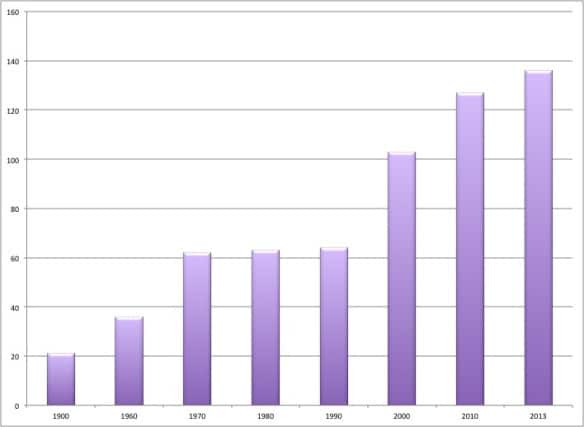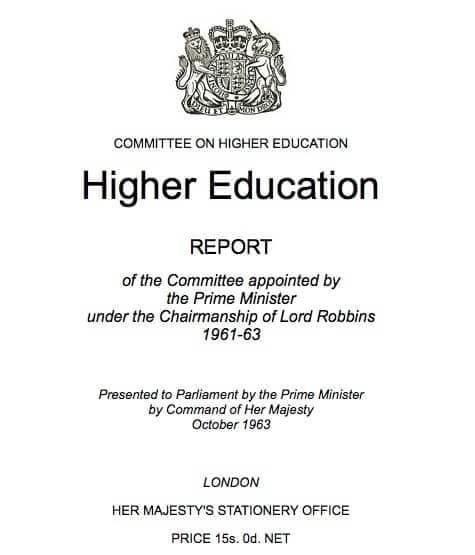All change please! Sectoral change since Robbins and into the future
Rewriting Robbins? The very thought
I recently agreed to give a presentation on this theme at an event entitled “Rewriting Robbins” by those lovely people at SGP Martineau.
You can find the full details of the event here and my rather fetching but nevertheless superficial parade of pictures here:
[slideshare id=28526494&style=border:1px solid #CCC;border-width:1px 1px 0;margin-bottom:5px&sc=no]
Apologies in advance
Having agreed to deliver such a presentation I quickly realized the mistake I’d made but by then it was too late. It was of course ridiculously presumptuous to undertake such an exercise and even to contemplate commenting on Robbins with the benefit of 50 years of hindsight seemed like an outrageous impertinence. So, apologies in advance for any offence caused.
There was recently a very good piece in the Times Higher on Robbins. Among the many interesting points was a recollection from one of his committee members, Claus Moser, that Robbins wrote nothing down during the many sessions of the Committee, preferring to commit data to his phenomenal memory. He then went off and wrote the whole report pretty much by himself. Another key factor was that is was intended to be thoroughly evidence-based. And you can see in the rigour of the investigations and the detail of the appendices that this was carried through. Robbins didn’t want to make recommendations which weren’t properly grounded.
Going for growth
A fundamental principle was the need to expand in order to meet the future needs of the country and the demand from a post-war population boom. He anticipated an increase in the APR from 8% in 1963 to 17% by 1980 meaning 216k students in 1962-3 rising to 560k by 1980-81.
And in facilitating this expansion the most famous Robbins Principle was invoked:
courses of higher education should be available for all those who are qualified by ability and attainment to pursue them and who wish to do so.
Part of the growth could be met by the new universities already under development or planned but there would still be a need for more places so Robbins proposed a range of additional institutions:
It may be that most of the university places that are required in the next ten years can be provided by such developments. But if no further steps are taken, the situation will thereafter be irretrievable, for universities take long to establish. We therefore recommend the immediate foundation of six new universities, of which at least one should be in Scotland. Another would be the new Special Institution for Scientific and Technological Education and Research. Such new foundations might provide 30,000 places by 1980. The remaining places should be provided by the advancement to university status of some ten Regional Colleges and Colleges of Education. If the scale of these recommendations should seem over-ambitious, we would remind the sceptics that demographic projections beyond 1980 suggest no lessening of the rate at which the demand for places will grow.
In short the growth would include:
- Six new universities should be established at once so that they can provide about 30,000 places by 1980/1.
- Teacher training institutions should become proper Colleges of Education and aligned with universities
- Three special Institutions for Scientific and Technological Education and Research should be created.
- Two postgraduate business schools, providing courses in management, should be developed, each in association with a university or a Special Institution and close to a large business centre.
- Scottish Central institutions – the most advanced should become universities
- A further 20,000 university places should be provided by giving university status to some ten Regional Colleges, Central Institutions and Colleges of Education.
- And in addition he proposed that the CATS, the Colleges of Advanced Technology should all become universities, each with 3-5000 students
(All of this is set out in Chapter X of the report although I must be honest that I found some of the institutional types difficult to disentangle on occasion.)
CATS and non-CATS

And sure enough in 1966, the CATS became universities. Some of these are obvious, others less so:
- Birmingham CAT became Aston University (the first designated College of Advanced Technology (or CAT))
- Loughborough CAT became Loughborough University
- Northampton CAT (London) became City University
- Chelsea CAT became Chelsea College of Science and Technology as part of the University of London then later was subsumed into King’s College London
- Battersea CAT became the University of Surrey
- Brunel CAT became Brunel University
- Bristol CAT became the University of Bath
- Cardiff CAT became part of the University of Wales, then Cardiff University
- Salford CAT (the Royal College of Advanced Technology) became the University of Salford
- Bradford Institute of Technology became University of Bradford
And just to complete the picture, the other universities founded in the 1960s:

1961 Sussex
1962 Keele
1962 Swansea
1963 East Anglia
1963 Newcastle
1963 York
1964 Lancaster
1964 Strathclyde
1965 Essex
1965 Kent
1965 Warwick
1966 Heriot-Watt
1967 Dundee
1967 Stirling
1969 Open
1969 Cranfield
Beyond Robbins: things really have moved on
Although the changes set in train by the report were substantial and far-reaching, since Robbins there has been a transformation in both the scale and reach of institutions (as well as total student numbers and the composition of the student body, which I didn’t cover here as they were addressed by others at the conference).
In looking for growth in existing institutions Robbins was anticipating universities of up to 10,000 students not the level of 30,000 which he associated with the big federal systems in the US. 10,000 students was big though:
In modern conditions it is desirable that universities should be large enough to have an adequate division of labour within departments and to make economical use of buildings and equipment.
But if we look at the sector in the UK now we have over 100 institutions with more than 10,000 students. More than half of these have over 20,000 students enrolled and leaving aside the Open University around a dozen have more than 30,000 students. A completely different scale.
What is also fascinating is to look at the growth in institutional numbers too. We have a huge growth during Robbins’ time but then a period of some stability before renewed and continuing expansion as this crude chart of UK university numbers demonstrates:

Beyond scale there are of course many other differences these days – from the pace of change to the volume of regulation and from the interconnectedness of institutions and activity to the sheer complexity of operations. In addition there is the international dimension: whilst the Committee accumulated plenty of learning from other countries it really didn’t anticipate our internationalized institutions or scale of global activity. The fact that there are now more than 435,000 students from overseas studying at UK universities and not a greatly smaller number studying for UK HE qualifications in other countries is a most remarkable transformation.
Moreover, whilst we might in the UK fret about mergers and takeovers and whether or not to establish campuses overseas in the meantime dozens of institutions from other parts of the world are establishing outposts and branches in the UK (mainly in London). Higher education is very much a global activity now.
What does the future hold?
So that was then and now, but what of the future? Predicting the future in higher education is of course a mug’s game. You can never win. However, it is difficult to resist the opportunity to take part.
So in a completely flawed and unscientific attempt to set out what might happen I offer four possible versions of the future:
The Wild West
Version 1 is the Wild West. It starts with the OFT smashing its way through our cozy higher education set up and leads to takeovers, merger mania and chaos with lots of institutions being allowed to go to the wall and many more private for-profit institutions springing up all over the place (every supermarket has one).
Government removes all attempts to manage the system and there is no meaningful regulation. The QAA is abolished, no need for any funding councils and there are no more committees of the great and good to pontificate on higher education. Anyone can set up and call themselves a university but in this environment only the richest, strongest and nastiest survive.
It’s the ultimate free market. In other words, higher education anarchy.
![Wonkhe Private Frazer]() Private Frazer
Private Frazer
Version 2 means that, unfortunately, we’re all doomed (which was Dad’s Army’s Private Frazer’s famous but rarely deployed catch phrase). The MOOC providers will win and kill most traditional universities. As Sebastian Thrun, founder of Udacity, predicted a few years ago there will be only 10 universities left in the world in 50 years’ time. Of course universities only have themselves to blame having nurtured, supported and then allowed the MOOC providers to disrupt the system. So if there are only going to be 10 around the world how many will be left in the UK? Oxford? Cambridge? The Open University?
(Fortunately this scenario is looking quite unlikely, Thrun is rapidly recanting and it could be that the MOOC bubble is already bursting.)
Regulated mediocrity
Version 3 represents something of a straightjacket with a levelling down to leave us with lots of rather similar universities, all beset and overwhelmed with ludicrously excessive bureaucracy designed to keep every stakeholder happy. We have ever more regulation overseen by a host of super-regulators, meta-regulators and regional regulators. It feels a bit like every aspect of university life is directly governed by the QAA.
Moreover, immigration regulations mean there are next to no international students and there are rigid targets for everything from widening participation to detailed specification of class contact hours, SSRs, assessment turnaround times, exam duration, graduation ticket fees and academic dress.
Students have more information available to them than has previously been written in all of human history and spend substantially more time filling in surveys on their experiences than undertaking any learning.
All too credible I fear.
Wildflower meadow
The final version is something a bit closer to a higher education ideal (relative to all of the others that is). It offers a lightly regulated and managed environment, well-tended, all collegial and harmonious. Many different flowers bloom and institutions co-exist in a state of delightful equilibrium. There is a perfect balance between teaching and research, the widening participation job is done and there is an optimal balance of different kinds of institution with different missions.

Some universities come and go, some last, some spread their wings but overall there is a perfect balance between market and regulation. It really is higher education nirvana.
Into uncharted territory
It is though very unclear what the future holds. Monsters, in the form of as yet unknown Ministers for Universities, and wild uncharted lands await. But we could do worse than note some more words of wisdom from half a century ago from Robbins:
The fundamental question that we have to answer is whether a system of higher education in the sense in which we have used the word ‘system’ is desirable. As we have said, it is misleading to speak as if there were already a system in this sense. Higher education has not been planned as a whole or developed within a framework consciously devised to promote harmonious evolution. What system there is has come about as the result of a series of particular initiatives, concerned with particular needs and particular situations, and there is no way of dealing conveniently with all the problems common to higher education as a whole.
Our point is that the central decisions that have to be made should be coherent and take account of the interests of all sectors of higher education, and that decentralised initiative – and we hope there will always be much of this – should be inspired by common principles.
Wise words?
Unfortunately, we couldn’t just leave it there. The whole series of Robbins quotes offered during this event (and bandied around more widely) led me to speculate on the possibility of a new parlour game which tested whether one was reading a real Robbins quote or a made up one. If you can bear it then do see the earlier post on this great new game the whole faculty can play: Robbins or Bobbins?
With the most profound apologies to Lord Robbins and all of his great works.














Reblogged this on Registrarism and commented:
Behind schedule so thought might get away with a reblog this recent post on Robbins and the future.